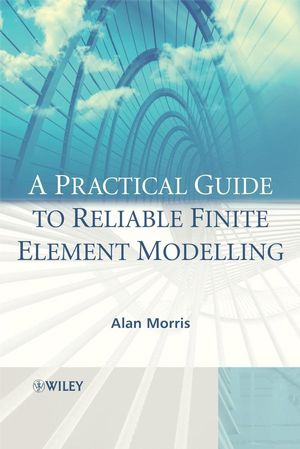|
Textbook
A Practical Guide to Reliable Finite Element ModellingISBN: 978-0-470-01832-3
Hardcover
384 pages
February 2008, ©2007
 This is a Print-on-Demand title. It will be printed specifically to fill your order. Please allow an additional 10-15 days delivery time. The book is not returnable.
|
||||||
Preface XIII
1 Introduction 1
1.1 Aim of the book 1
1.2 Finite element types – a brief overview 3
1.3 Finite element analysis and finite element representations 6
1.4 Multi-model analyses 8
1.5 Consistency, logic and error control 8
1.6 Chapter contents 11
1.6.1 Chapter 2 Overview of static finite element analysis 11
1.6.2 Chapter 3 Overview of dynamic analysis 12
1.6.3 Chapter 4 What’s energy got to do with it? 13
1.6.4 Chapter 5 Preliminary review of errors and error control 14
1.6.5 Chapter 6 Discretisation: elements and meshes or some ways to avoid generated error 14
1.6.6 Chapter 7 Idealisation error types and sources 15
1.6.7 Chapter 8 Error control 15
1.6.8 Chapter 9 Error-controlled analyses 16
1.6.9 Chapter 10 FEMEC walkthrough example 17
References 17
2 Overview of Static Finite Element Analysis 19
2.1 Introduction 19
2.2 The direct method for static analyses 20
2.2.1 Element matrices 20
2.2.2 Assembled global stiffness matrix for static analyses 21
2.2.3 Global coordinates 26
2.2.4 Some typical elements 29
2.2.5 The analysis loop 29
2.3 Reducing the problem size 33
2.3.1 Symmetry 33
2.3.2 Condensation and superelements 40
2.3.3 Sub-structures 46
References 49
3 Overview of Dynamic Analysis 51
3.1 Introduction 51
3.2 Element mass matrix 51
3.2.1 Free undamped vibrations 53
3.3 Additional information that can be extracted to support a dynamic finite element analysis 59
3.3.1 Sturm property check 59
3.3.2 Rayleigh Quotient 61
3.4 Forced responses 62
3.4.1 Modal analysis 62
3.4.2 Direct integration 65
3.5 Damped forced responses 66
3.5.1 Modal analysis with damping 66
3.5.2 Modal damping ratio 68
3.5.3 Direct integration 69
3.6 Reducing the problem size 70
3.6.1 Symmetry 71
3.6.2 Reducing the number of variables 72
3.6.3 Sub-structure analysis (component mode synthesis) 76
References 78
4 What’s Energy Got to Do with It? 79
4.1 Introduction 79
4.2 Strain energy 81
4.3 Potential energy 82
4.4 Simple bar 83
4.5 General case 83
4.6 Minimum potential energy 84
4.7 The principle of minimum potential energy applied to a simple finite element problem 86
4.8 Finite element formulation 88
4.9 Direct application to an axial bar element 90
4.10 Convergence in energy and convergence in stress 92
4.10.1 Single bar element model 94
4.10.2 2-bar element model 96
4.10.3 4-bar element model 98
4.10.4 8-bar element model 101
4.10.5 16-bar element model 102
4.11 Results interpretation 103
4.11.1 Potential energy convergence 103
4.11.2 Stress improvement 104
4.11.3 Displacement convergence 106
4.12 Kinetic energy 106
4.13 Final remarks 111
References 111
5 Preliminary Review of Errors and Error Control 113
5.1 Introduction 113
5.2 The finite element process 114
5.3 Error and uncertainty 117
5.4 Novelty, complexity and experience 120
5.4.1 Analysis novelty 120
5.4.2 Degree of complexity 123
5.4.3 Experience 125
5.5 Role of testing 128
5.6 Initial steps 129
5.6.1 Qualification process 129
5.6.2 Acceptable magnitude of error or uncertainty 132
5.7 Analysis Validation Plan (AVP) 135
5.8 Applied common sense 138
5.9 The process 140
References 141
6 Discretisation: Elements and Meshes or Some Ways to Avoid Generated Error 143
6.1 Introduction 143
6.2 Element delivery 144
6.2.1 Two-dimensional elements 145
6.2.2 Three-dimensional elements 148
6.2.3 Why do this? 151
6.2.4 Optimal stress points and making the most of them 151
6.3 Mesh grading and mesh distortion 155
6.3.1 Mesh grading 155
6.3.2 Element distortions 158
6.3.3 Group 3 distortions (quadratic distortions) 161
6.3.4 Group 4 distortions (cubic and higher order distortions) 162
6.3.5 Distortions of other element types 162
6.3.6 General principles with respect to element distortions 163
6.4 The accuracy ladder 164
6.4.1 The stress ladder 164
6.4.2 The mesh ladder 165
6.4.3 Automatically moving up the accuracy ladder 165
References 174
7 Idealisation Error Types and Sources 175
7.1 Design reduction and idealisation errors 175
7.2 Analysis features 178
7.3 The domain 180
7.3.1 The domain of analysis 180
7.3.2 Domain reduction 183
7.4 Levels of abstraction 184
7.5 Boundary conditions 192
7.6 Material properties 198
7.7 Loads and masses 200
7.7.1 Loads 200
7.7.2 Masses 201
References 201
8 Error Control 203
8.1 Introduction 203
8.2 Approach and techniques 204
8.2.1 Approach 204
8.2.2 Techniques 207
8.3 Accumulation of errors and uncertainties 241
8.4 The role of testing 242
8.4.1 Analyst-requested tests 244
8.4.2 Validation test 245
References 247
9 Error-Controlled Analyses 249
9.1 Introduction 249
9.2 Is the finite element system fit for purpose? 251
9.2.1 What does it do? 251
9.2.2 How do we know it does it? 252
9.2.3 Is size important? 254
9.3 Quality Report 256
9.4 The error and uncertainty control method 259
9.4.1 Introduction 259
9.4.2 FEMEC 260
9.4.3 FEMEC implementation process 261
10 FEMEC Walkthrough Example 303
10.1 Introduction 303
10.2 FEMEC static analysis illustrative problem 304
10.2.1 The design requirement 304
10.2.2 Application of FEMEC via the Quality Report 306
10.3 A brief look at the dynamic FEMEC world 345
10.3.1 Modified design and qualification parameters 345
10.3.2 FEMEC approach 346
References 351
Index 353



